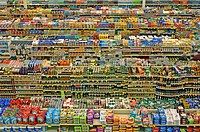The food industry is a complex, global network of diverse businesses that supplies most of the food consumed by the world's population. The food industry today has become highly diversified, with manufacturing ranging from small, traditional, family-run activities that are highly labour-intensive, to large, capital-intensive and highly mechanized industrial processes. Many food industries depend almost entirely on local agriculture, animal farms, produce, and/or fishing.[1]
It is challenging to find an inclusive way to cover all aspects of food production and sale. The UK Food Standards Agency describes it as "the whole food industry – from farming and food production, packaging and distribution, to retail and catering".[2] The Economic Research Service of the USDA uses the term food system to describe the same thing, stating: "The U.S. food system is a complex network of farmers and the industries that link to them. Those links include makers of farm equipment and chemicals as well as firms that provide services to agribusinesses, such as providers of transportation and financial services. The system also includes the food marketing industries that link farms to consumers, and which include food and fiber processors, wholesalers, retailers, and foodservice establishments."[3] The food industry includes:
- Agriculture: raising crops, livestock, and seafood. Agricultural economics.
- Manufacturing: agrichemicals, agricultural construction, farm machinery and supplies, seed, etc.
- Food processing: preparation of fresh products for market, and manufacture of prepared food products
- Marketing: promotion of generic products (e.g., milk board), new products, advertising, marketing campaigns, packaging, public relations, etc.
- Wholesale and food distribution: logistics, transportation, warehousing
- Foodservice (which includes catering)
- Grocery, farmers' markets, public markets and other retailing
- Regulation: local, regional, national, and international rules and regulations for food production and sale, including food quality, food security, food safety, marketing/advertising, and industry lobbying activities
- Education: academic, consultancy, vocational
- Research and development: food science, food microbiology, food technology, food chemistry, and food engineering
- Financial services: credit, insurance
Areas of research such as food grading, food preservation, food rheology, food storage directly deal with the quality and maintenance of quality overlapping many of the above processes.
Only subsistence farmers, those who survive on what they grow, and hunter-gatherers can be considered outside the scope of the modern food industry.
The dominant companies in the food industry have sometimes been referred to as Big Food, a term coined by the writer Neil Hamilton.[4][5][6][7]
- ^ Parmeggiani, Lougi, ed. (1983). "???". Encyclopædia of Occupational Health and Safety (3rd ed.). Geneva: International Labour Office. ISBN 9221032892.
- ^ "Industry". Food Standards Agency (UK). Archived from the original on 2012-06-05. Retrieved 2010-12-09.
- ^ "Food market structures: Overview". Economic Research Service (USDA).
- ^ Sue Booth; John Coveney (19 February 2015). Food Democracy: From consumer to food citizen. Springer. pp. 3–. ISBN 978-981-287-423-8.
- ^ Gray, Allison; Hinch, Ronald (1 October 2019). A Handbook of Food Crime: Immoral and Illegal Practices in the Food Industry and What to Do About Them. Policy Press. pp. 371–. ISBN 978-1-4473-5628-8.
- ^ Booth, Sue; Coveney, John (2015), Booth, Sue; Coveney, John (eds.), "'Big Food'—The Industrial Food System", Food Democracy: From consumer to food citizen, SpringerBriefs in Public Health, Singapore: Springer, pp. 3–11, doi:10.1007/978-981-287-423-8_2, ISBN 978-981-287-423-8, retrieved 26 November 2020
- ^ Stuckler, David; Nestle, Marion (19 June 2012). "Big Food, Food Systems, and Global Health". PLOS Medicine. 9 (6): e1001242. doi:10.1371/journal.pmed.1001242. ISSN 1549-1676. PMC 3378592. PMID 22723746.



